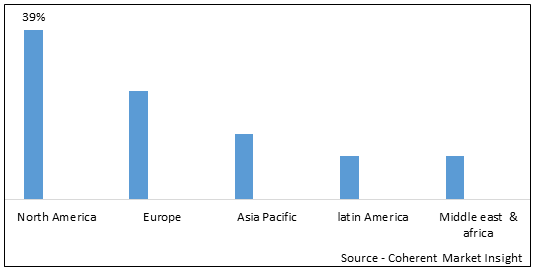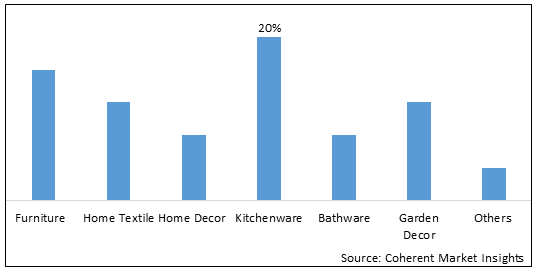Online Home Decor Market is estimated to be valued at USD 120.65 Bn in 2025 and is expected to reach USD 255.27 Bn in 2032, exhibiting a compound annual growth rate (CAGR) of 11.3% from 2025 to 2032. Online home decor includes products such as furniture, textiles, decorative accessories, and more that are purchased online for residential or commercial spaces. The growth is driven by rising disposable incomes, growth of the real estate sector, and increasing penetration of online shopping. The online home decor market is segmented by product type, price range, distribution channel, end user, material type, and region. By product type, the furniture segment is expected to dominate the market during the forecast period due to growing demand for customized and modular furniture.
Online Home Decor Market Regional Insights
Figure 1. Global Online Home Decor Market Share (%), by Region, 2025

To learn more about this report, Request sample copy
Online Home Decor Market Drivers
Online Home Decor Market Opportunities
Online Home Decor Market Trends
Online Home Decor Market Report Coverage
| Report Coverage | Details | ||
|---|---|---|---|
| Base Year: | 2024 | Market Size in 2025: | USD 120.65 Bn |
| Historical Data for: | 2020 To 2024 | Forecast Period: | 2025 To 2032 |
| Forecast Period 2025 to 2032 CAGR: | 11.3% | 2032 Value Projection: | USD 255.27 Bn |
| Geographies covered: |
|
||
| Segments covered: |
|
||
| Companies covered: |
Amazon, Bed Bath & Beyond, Walmart, Wayfair, IKEA, Overstock.com, Target, Home Depot, Williams-Sonoma, Lowe’s, Etsy, eBay, HomeGoods, JCPenney, Kohl’s, Macy’s, Pier 1 Imports, Crate and Barrel, At Home Stores, and Restoration Hardware |
||
| Growth Drivers: |
|
||
| Restraints & Challenges: |
|
||
Uncover macros and micros vetted on 75+ parameters: Get instant access to report
Online Home Decor Market Restrains
Analyst View
The online home decor market has tremendous growth opportunities driven by increasing internet and smartphone penetration. More consumers are now comfortable shopping for decor items online as online retailers offer greater convenience and choice. The ability to view high-resolution images and read detailed product descriptions online aids customers in virtual shopping and makes online an attractive purchase channel. Further, multiple payment options and easy return policies have boosted customer confidence in online purchases.
However, not being able to physically see and feel products remains a key restraint for the online home decor market. Many customers still prefer visiting brick-and-mortar stores to choose decor items. Additionally, online merchants struggle with the high shipping costs of bulky items and last-mile deliveries to remote locations. Marketers also find it challenging to build an emotional connection required for decorative purchases without visual merchandising used in stores.
With strong investments to enhance virtual and augmented reality-based shopping experiences, this restraint can be reduced. The online home decor space in Southeast Asia and Latin America is expected to grow the fastest as rising affluence and internet access in these regions drive the market. In contrast, the North American market is relatively mature with heavy offline competition in the home furnishings space.
Overall, the online home decor category has high growth potential but marketers need innovative strategies to overcome the “touch-and-feel” limitations of online shopping for decorative categories.
Recent Developments
New product launches
Acquisition and partnerships
Figure 2. Global Online Home Decor Market Share (%), by Product Type, 2025

To learn more about this report, Request sample copy
Top Companies in Online Home Decor Market
Definition: The online home decor market consists of the sales of home furnishings, furniture, home accessories, and decorative items through e-commerce online channels. It excludes offline sales through physical stores. Online platforms like company websites, apps, and marketplaces offer a wide range of decor products for different spaces and rooms including furniture, upholstery, carpets & flooring, lighting, decorative accents, kitchen & dining accessories, bath fittings, textiles, garden accessories, and more. The online distribution channel gives consumers convenience and a wider choice. Market growth is driven by increasing internet penetration, growth in online spending, rise in disposable incomes, and growth of the real estate sector globally.
Share
Share
About Author
Yash Doshi is a Senior Management Consultant. He has 12+ years of experience in conducting research and handling consulting projects across verticals in APAC, EMEA, and the Americas.
He brings strong acumen in helping chemical companies navigate complex challenges and identify growth opportunities. He has deep expertise across the chemicals value chain, including commodity, specialty and fine chemicals, plastics and polymers, and petrochemicals. Yash is a sought-after speaker at industry conferences and contributes to various publications on topics related commodity, specialty and fine chemicals, plastics and polymers, and petrochemicals.
Missing comfort of reading report in your local language? Find your preferred language :
Transform your Strategy with Exclusive Trending Reports :
Frequently Asked Questions
Select a License Type
Credibility and Certifications

860519526

9001:2015
27001:2022


Joining thousands of companies around the world committed to making the Excellent Business Solutions.
View All Our Clients
US Reciprocal Tax Impact Analysis On Online Home Decor Market
Stay updated on tariff changes with expert insights and timely information